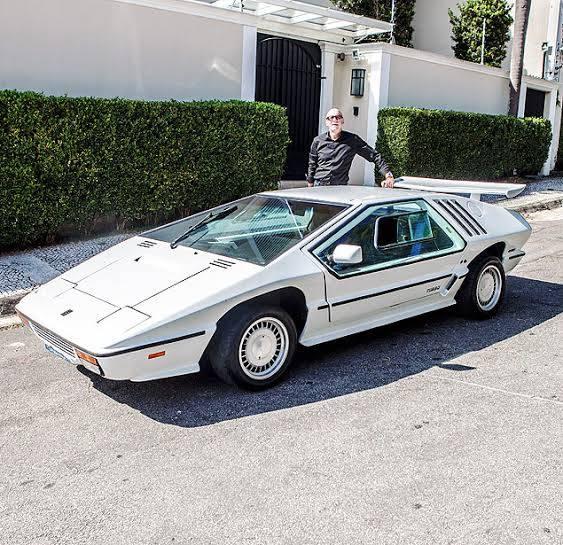 |
Mario Richard Hofstetter, with his eponymous creation
|
Perhaps the most radically styled car ever manufactured in Brazil, the Hofstetter was designed in 1973 in Switzerland, drawing inspiration from the state-of-the-art Italian concept cars of the time, especially the Maserati Boomerang, designed by Giugiaro of Ital-Design. Conceived by a Brazilian of Swiss descent, Mário Richard Hofstetter, the production of the car was delayed following its debut, only happening many years later in São Paulo (SP).
 |
The Hofstetter, as originally shown, sans wing and sliding side windows
|
An initial prototype was built in Switzerland and in 1982 the second one was started, with a new chassis, in Brazil. Its fiberglass body, shaped like a very sharp wedge, barely reached 1.03 m in height. It had pop-up headlights, doors that opened in a gull-wing style with fixed windows, requiring the permanent use of air conditioner. The interior, which was well finished, featured leather upholstery, complete instrumentation, and a small sports steering wheel only 30 cm in diameter. The T-shaped backbone chassis was composed of tubular elements ten inches in diameter with cross members at each end, and was designed to receive drivetrains from standard cars. It used the four-speed transmission and 1.6 liter engine assembly of the Volkswagen Passat (following, 5 gears and 1.8 Gol GT turbo), along with the front suspension of the Chevrolet Chevette, and the rear suspension was composed of the Passat's McPherson front assembly, in inverted position. A kombi diesel cooling system was used, and the car came with ventilated four wheel disc brakes. Neither steering nor brakes had powered assistance.
 |
The Hofstetter Turbo
|
The Hofstetter made a sensation at the 13th National Motor Show (in 1984), where it was first shown to the public. The manufacture of the car was started in mid-1986, through Hofstetter Indústria e Comércio de Veículos Ltda., with limited production, slated for 30 copies per year. By the end of the following year, however, only 13 units had been sold.
 |
The well appointed interior of the Hofstetter was quite impressive for the time.
|
Some improvements were introduced over time: in 1986, the car gained digital gauges, larger door openings, and the added option of an automatic transmission. The following year, a large airfoil was introduced in the rear as well as a small sliding window into the driver's side door glass. In 1988, it received the new 2.0 liter engine of the Santana, equipped with turbocharger, allowing the car to reach 210 hp.
 |
A later model, showing side-skirts and revised fascia
|
Finally, the last iteration featured a small front spoiler, side skirts, a sliding passenger side window, an oval steering wheel, new headlights and taillights, and a slightly lowered floor-pan. By then the car was manufactured by Technodesign Mechanics Industry and Commerce Ltda., as the Hofstetter-Cut, reference to the surname of the new company owner. In 1993 the 19th unit was waiting for a buyer.
Apparently, this was the last Hofstetter produced.
Sources:
 |
An early example of the Hofstetter
|
 |
| An early example of the Hofstetter Turbo |
 |
| An early example of the Hofstetter Turbo |
 |
| An interior shot of the Hofstetter |
 |
| A late series example of the Hofstetter |
 |
| The Hofstetter Turbo |
 |
| The Hofstetter Turbo |
 |
| The Hofstetter Turbo |
 |
| The Hofstetter Turbo |
 |
| The Hofstetter Turbo (photo: Garagem Belote) |



















Comments
Post a Comment